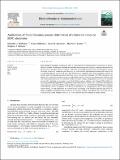| dc.contributor.author | Williams, Nicholas J | |
| dc.contributor.author | Osborne, Conor | |
| dc.contributor.author | Seymour, Ieuan D | |
| dc.contributor.author | Bazant, Martin Z | |
| dc.contributor.author | Skinner, Stephen J | |
| dc.date.accessioned | 2024-10-28T18:40:10Z | |
| dc.date.available | 2024-10-28T18:40:10Z | |
| dc.date.issued | 2023-04 | |
| dc.identifier.uri | https://hdl.handle.net/1721.1/157440 | |
| dc.description.abstract | Electrochemical impedance spectroscopy (EIS) is a powerful tool in characterisation of processes in electrochemical systems, allowing us to elucidate the resistance and characteristic frequency of physical properties such
as reaction and transport rates. The essence of EIS is the relationship between current and potential at a given
frequency. However, it is often the case that we do not understand the electrochemical system well enough to fit
a meaningful physical model to EIS data. The distribution of relaxation times (DRT) calculation assumes an
infinite series of relaxation processes distributed over a characteristic timescale. The DRT calculation may
identify the number of processes occurring, as well as their respective resistivity and characteristic timescale, and
may resolve processes which have relatively similar timescales. Using a nonparametric tool known as Gaussian
process (GP) regression, we showcase a method of finding a unique solution to the ill-posed DRT problem by
optimising kernel hyperparameters as opposed to ad-hoc regularisation. In this work, we use finite GP regression
under inequality constraints (fGP) to analysed EIS data generated by a (Ni/CGO|CGO|YSZ|Reference Cathode)
solid-oxide fuel cell in a gas mixture of 0.5 bar H2/0.5 bar H2O and at a temperature of 600 ◦C. By varying the
current density, we can characterise the current-voltage relationship of the electrode and shed light on the reaction mechanism governing charge transfer at the solid-gas interface. Our findings also show that even at
relatively high current densities (±600 mA cm− 2) the electrode process is limited by charge transfer. | en_US |
| dc.language.iso | en | |
| dc.publisher | Elsevier BV | en_US |
| dc.relation.isversionof | 10.1016/j.elecom.2023.107458 | en_US |
| dc.rights | Creative Commons Attribution | en_US |
| dc.rights.uri | https://creativecommons.org/licenses/by/4.0/ | en_US |
| dc.source | Elsevier BV | en_US |
| dc.title | Application of finite Gaussian process distribution of relaxation times on SOFC electrodes | en_US |
| dc.type | Article | en_US |
| dc.identifier.citation | Williams, Nicholas J, Osborne, Conor, Seymour, Ieuan D, Bazant, Martin Z and Skinner, Stephen J. 2023. "Application of finite Gaussian process distribution of relaxation times on SOFC electrodes." Electrochemistry Communications, 149. | |
| dc.contributor.department | Massachusetts Institute of Technology. Department of Chemical Engineering | en_US |
| dc.contributor.department | Massachusetts Institute of Technology. Department of Mathematics | en_US |
| dc.relation.journal | Electrochemistry Communications | en_US |
| dc.eprint.version | Final published version | en_US |
| dc.type.uri | http://purl.org/eprint/type/JournalArticle | en_US |
| eprint.status | http://purl.org/eprint/status/PeerReviewed | en_US |
| dc.date.updated | 2024-10-28T18:25:31Z | |
| dspace.orderedauthors | Williams, NJ; Osborne, C; Seymour, ID; Bazant, MZ; Skinner, SJ | en_US |
| dspace.date.submission | 2024-10-28T18:25:33Z | |
| mit.journal.volume | 149 | en_US |
| mit.license | PUBLISHER_CC | |
| mit.metadata.status | Authority Work and Publication Information Needed | en_US |
